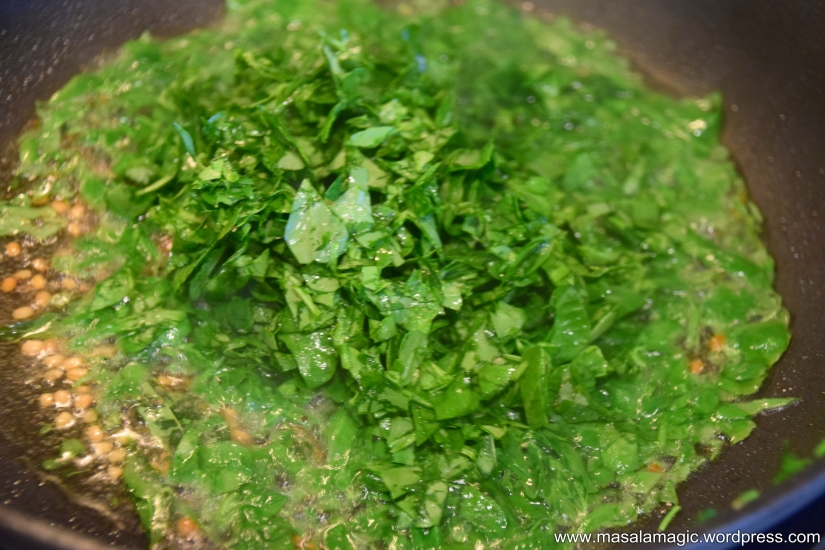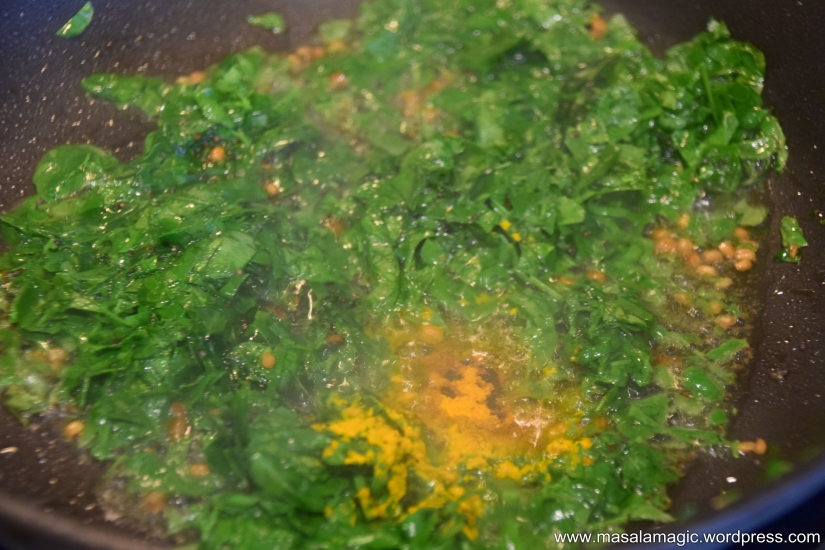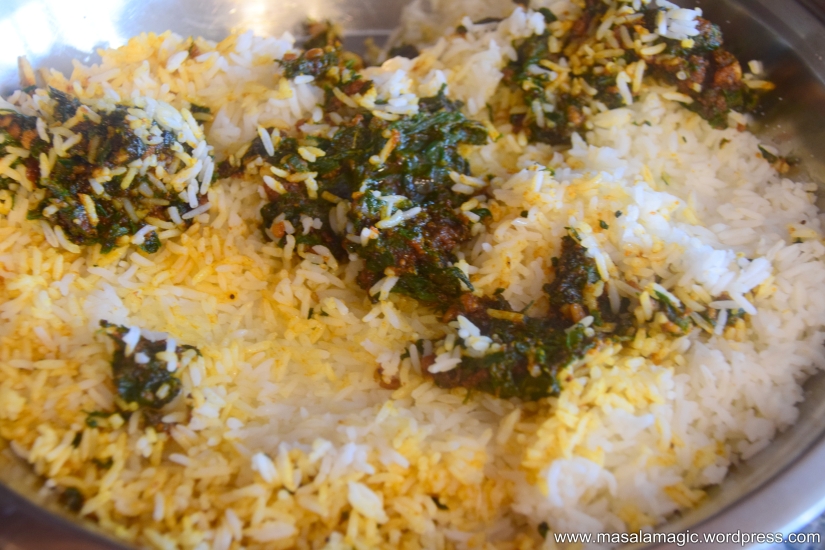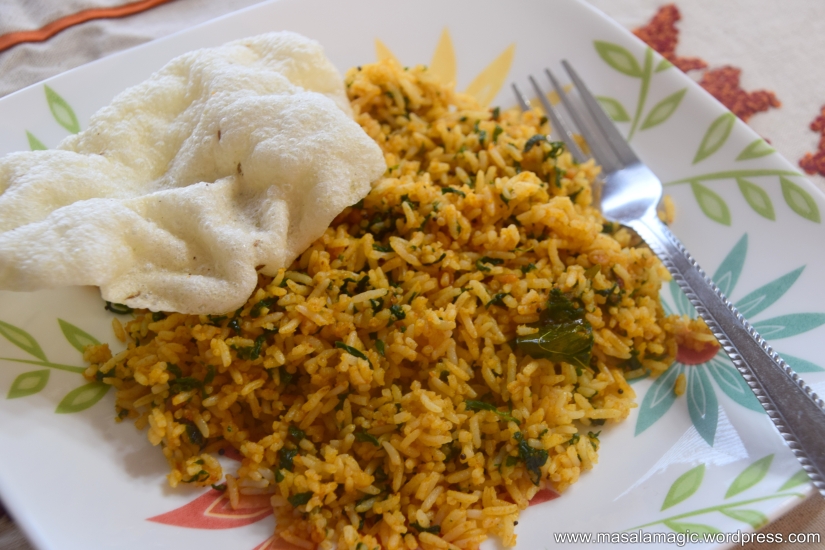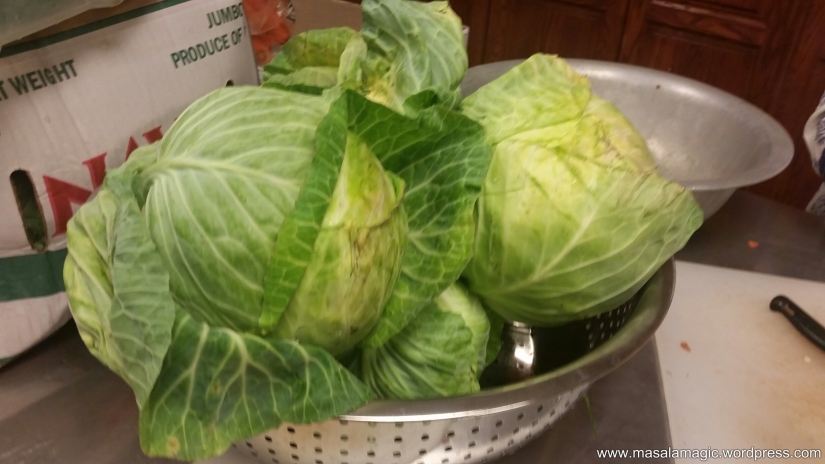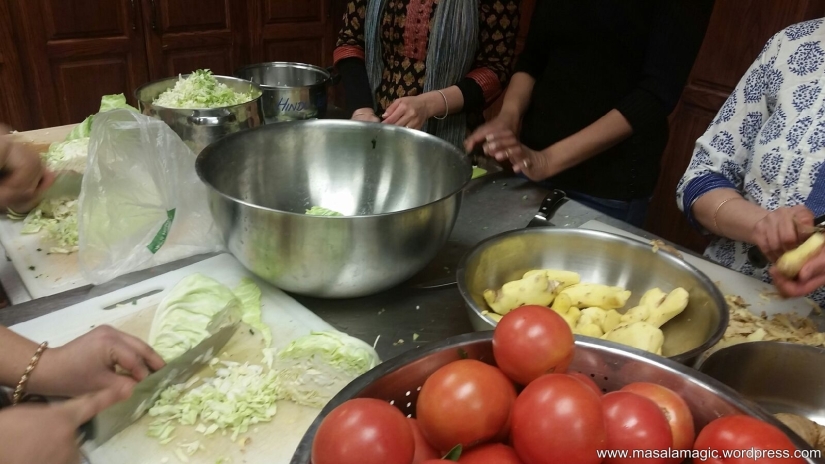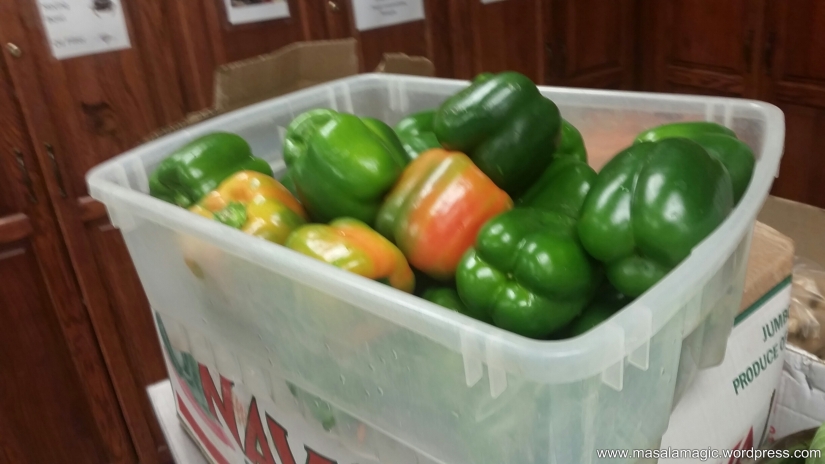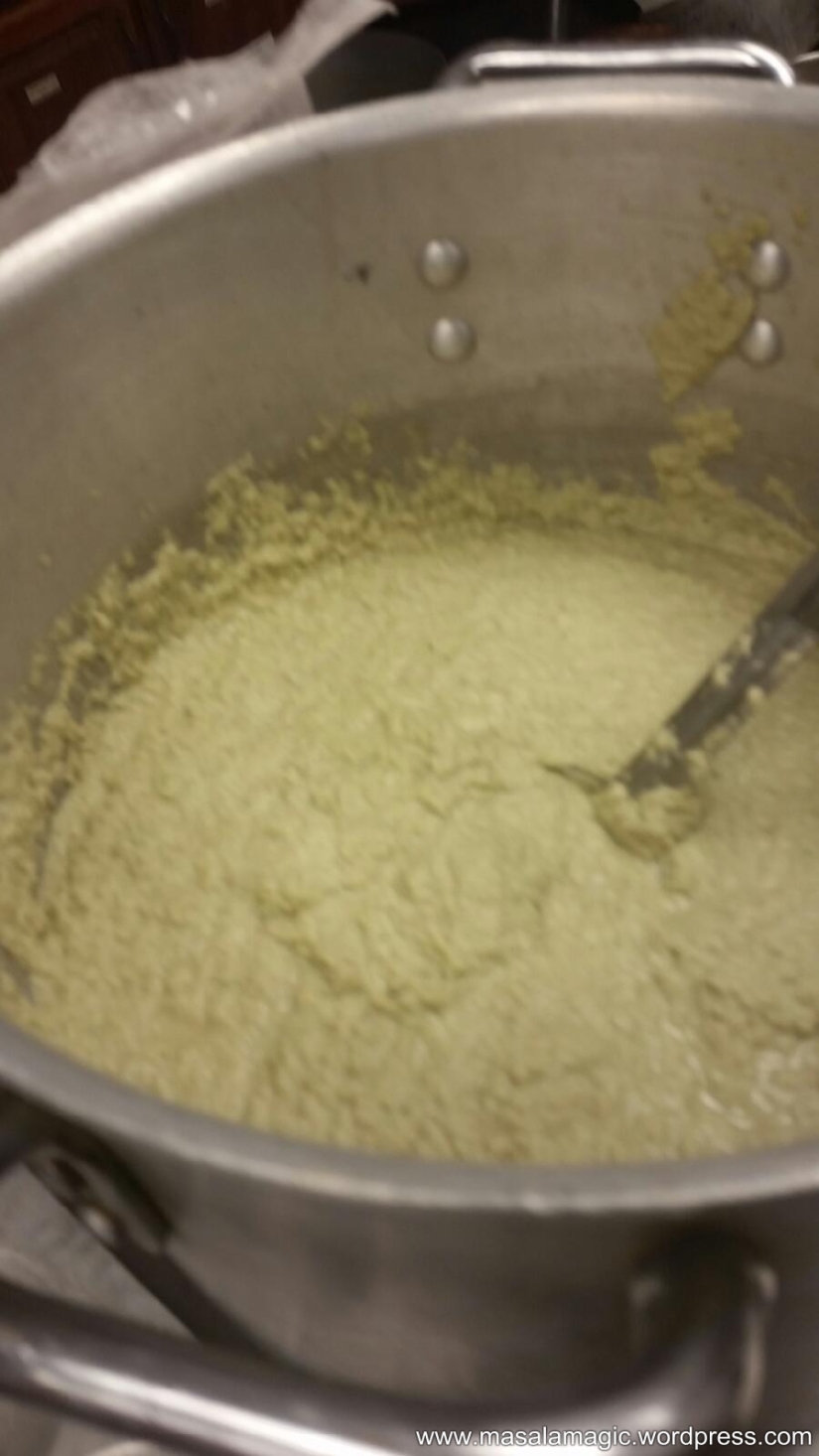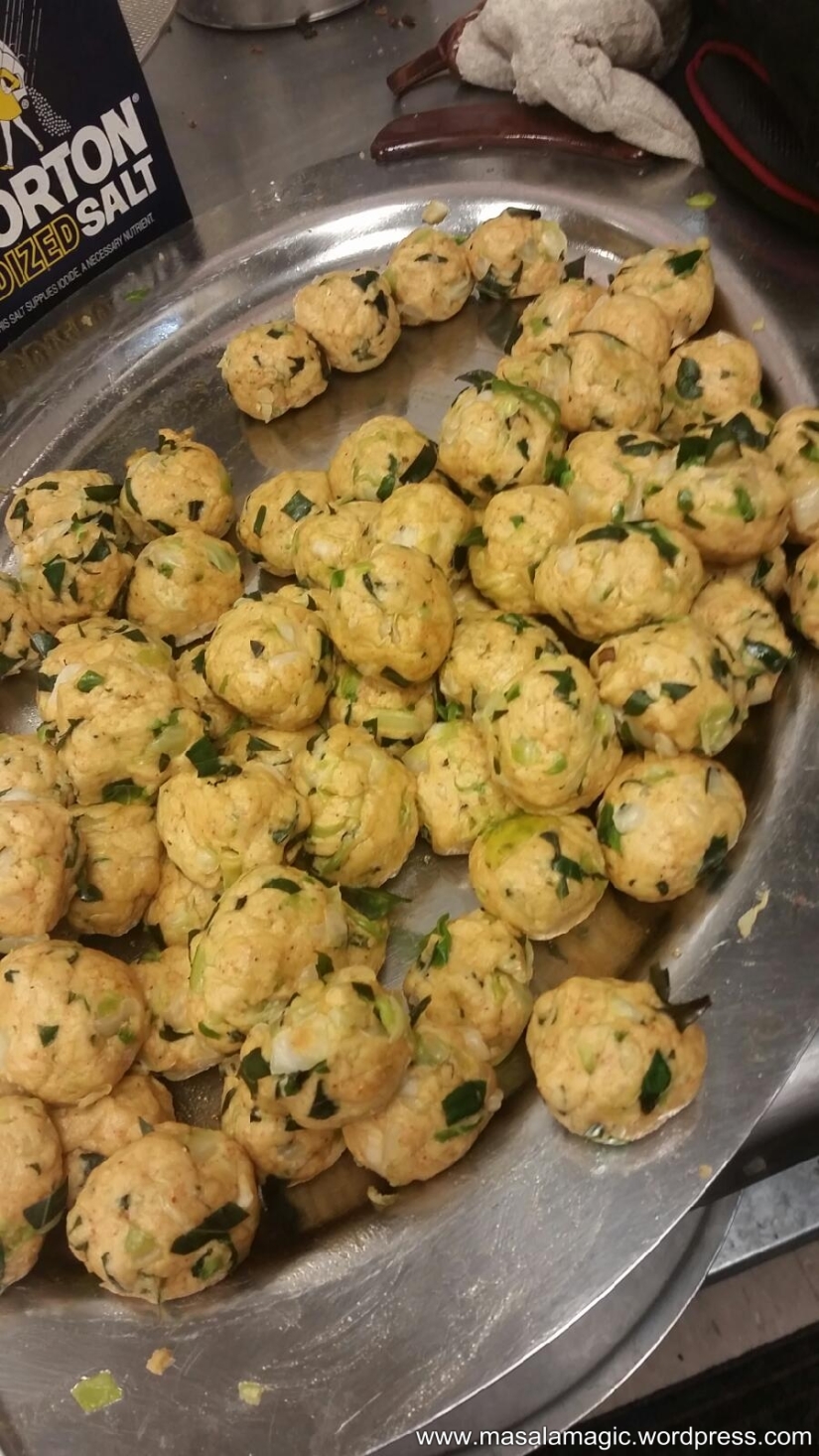Methi or Fenugreek is by far my most favorite greens. I love the fragrant, slightly bitter taste of this leafy vegetable. Indian cooking uses methi in plenty of dishes and in various forms. Methi Parathas, Methi Dal, Methi Matar Malai, Methi Khakras etc are common methi dishes that are very popular.
However, this morning had me craving for a traditional methi rice dish that is typically made in my home. The good thing about all these wonderful food blogs in blogsphere is that you get to here stories and recipes about homemade dishes that you probably will never find in any cookboook 🙂 This is one of those kind of recipes…
Simple and easy to make…the main ingredients in this dish is “Vangi Bhaat Powder” and of course Methi.
Vangi Bhaat Powder as the name implies is typically used to make Brinjal/Eggplant Rice – “Vangi” means Eggplant/Brinjal in several Indian dialects/languages.This recipe uses the same powder except replacing the Brinjal with Methi.So, let’s start with the powder…
Vangi Bhaat Powder:

You will need:
1 Cup Channa Dal
1 Cup Urad Dal
3/4 Cup Dry Red Chillies (I use a mix of Guntur Spicy Red Chillies and Byadgi Red chillies that have the fiery red colour)
3/4 Cup Dhaniya
Hing – 1/2 tsp
Cinnamon bark (Dal chini) – about 10 small pieces
Cloves (Laung) – about 10
In a pan dry roast each of the ingredients separately on medium flame. Ensure that you keep stirring while roasting the dals. Roast the dals to a golden brown. While roasting dry red chillies, you may add the hing/asafoetida powder and add a few drops of oil. While dry roasting Dhaniya, you may roast the cinnamon and cloves with it.
Roast and allow to cool.
Combine all of the ingredients and grind into a fine powder.
My mom and aunts make vangi bhaat powder in small batches as and when needed, as it tastes best fresh. I am a little lazy, so I grind a slightly bigger batch and store in an air tight container. This stays pretty fresh too and it always easier to have this powder handy. It can be used in multiple dishes 🙂
Methi Rice:
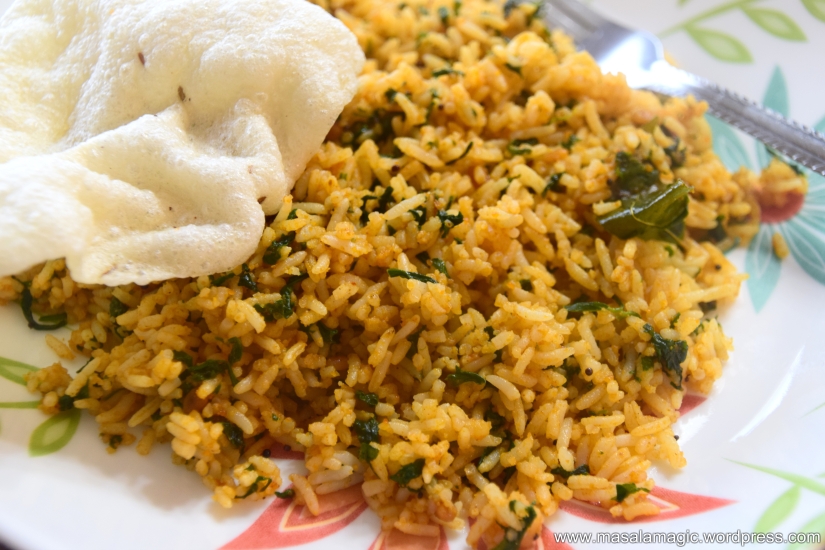
You will need:
Fresh Methi – 1 Bunch
Vangi Bhaat Powder – 2 Tbsp
Turmeric Powder – 1/2 tsp
Salt to taste
Cooked Rice – 2 Cups
Oil – 3 tbsp
For Seasoning:
Mustard seeds
Urad Dal
Curry Leaves
Hing/Asafoetida
Method:
1. Remove the tender methi leaves and discard the stalk.
2. Wash the methi leaves and chop fine.
3. Cook the Rice in a rice cooker (I use Sona Masoori Rice, 1 cup rice to 2.5 cups water ratio). After the rice is done, spread in a large platter or mixing bowl to cool. Add salt as required on the cooked rice.
4. In a Pan, heat about 2 tsp oil. Season with mustard seeds, hing and urad dal.
5. When the dal turns golden brown add the curry leaves.
6. Then add the chopped methi and mix well.
7. Add turmeric powder and mix.
8. Add salt to taste(just enough for the methi -so about 1/4 tsp). Mix.
9. Add about 1/2 cup water.
10. Cover with a lid and cook until all the water evaporates.
11. Add the Vangi bhaat powder.
12. Mix well.
13. Add the methi mixture to the cooled, cooked rice. If it seems too dry, add about 1 tbsp oil. Mix well. Ensure that you mix gently so as to not break the rice. Mixing with hands actually works out best, it allows to mix evenly.
14. Serve with papad. You can even serve with Raita…
Enjoy!
Mahashivratri
I read in a blog by Sadhguru of isha foundation, the true significance of Mahashivratri – Kind off a long read, but very beautiful and insightful…
“In the Indian culture, at one time, there used to be 365 festivals in a year. In other words, they just needed an excuse to celebrate everyday of the year. These 365 festivals were ascribed to different reasons, and for different purposes of life. There were to celebrate various historical events, victories, or certain situations in life like harvesting, planting, and reaping. For every situation there was a festival. But Mahashivarathri is of a different significance.
The fourteenth day of every lunar month or the day before the new moon is known as Shivarathri. Among all the twelve Shivarathris that occur in a calendar year, Mahashivarathri, the one that occurs in February-March is of the most spiritual significance. On this night, the northern hemisphere of the planet is positioned in such a way that there is a natural upsurge of energy in a human being. This is a day when nature is pushing one towards one’s spiritual peak. It is to make use of this, that in this tradition, we establish a certain festival which is night-long. One of the fundamentals of this night-long festival is to ensure that – to allow this natural upsurge of energies to find their way – you remain with your spine vertical – you stay awake.
Mahashivarathri is very significant for people who are on the spiritual path. It is also very significant for people who are in family situations, and also for the ambitious in the world. People who live in family situations observe Mahashivarathri as Shiva’s wedding anniversary. Those with worldly ambitions see that day as the day Shiva conquered all his enemies.
But, for the ascetics, it is the day he became one with Mount Kailash. He became like a mountain – absolutely still. In the yogic tradition, Shiva is not worshipped as a God, but considered as the Adi Guru, the first Guru from whom the knowledge originated. After many millennia in meditation, one day he became absolutely still. That day is Mahashivarathri. All movement in him stopped and he became utterly still, so ascetics see Mahashivarathri as the night of stillness.
Legends apart, why this day and night are held in such importance in the yogic traditions is because of the possibilities it presents to a spiritual seeker. Modern science has gone through many phases and arrived at a point today where they are out to prove to you that everything that you know as life, everything that you know as matter and existence, everything that you know as the cosmos and galaxies, is just one energy which manifests itself in millions of ways.
This scientific fact is an experiential reality in every yogi. The word “yogi” means one who has realized the oneness of the Existence. When I say “yoga,” I am not referring to any one particular practice or system. All longing to know the unbounded, all longing to know the oneness in the Existence is yoga. The night of Mahashivarathri offers a person an opportunity to experience this.
Shivarathri, is the darkest day of the month. Celebrating Shivarathri on a monthly basis, and the particular day, Mahashivarathri, almost seems like celebration of darkness. Any logical mind would resist darkness and naturally opt for light. But the word “Shiva” literally means “that which is not.” “That which is,” is existence and creation. “That which is not” is Shiva. “That which is not” means, if you open your eyes and look around, if your vision is for small things, you will see lots of creation. If your vision is really looking for big things, you will see the biggest presence in the existence is a vast emptiness. A few spots which we call galaxies are generally much noticed, but the vast emptiness that holds them does not come into everybody’s notice. This vastness, this unbounded emptiness, is what is referred to as Shiva. Today, modern science also proves that everything comes from nothing and goes back to nothing. It is in this context that Shiva, the vast emptiness or nothingness, is referred to as the great lord, or Mahadeva.
Every religion, every culture on this planet has always been talking about the omnipresent, all-pervading nature of the divine. If we look at it, the only thing that can be truly all-pervading, the only thing that can be everywhere is darkness, nothingness, or emptiness. Generally, when people are seeking wellbeing, we talk of the divine as light. When people are no longer seeking wellbeing, when they are looking beyond their life in terms of dissolving, if the object of their worship and their sadhana is dissolution, then we always refer to the divine as darkness.
Light is a brief happening in your mind. Light is not eternal, it is always a limited possibility because it happens and it ends. The greatest source of light that we know on this planet is the sun. Even the sun’s light, you could stop it with your hand and leave a shadow of darkness behind.
But darkness is all-enveloping, everywhere. The immature minds in the world have always described darkness as the devil. But when you describe the divine as all-pervading, you are obviously referring to the divine as darkness, because only darkness is all-pervading. It is everywhere. It does not need any support from anything. Light always comes from a source that is burning itself out. It has a beginning and an end. It is always from a limited source. Darkness has no source. It is a source unto itself. It is all-pervading, everywhere, omnipresent. So when we say Shiva, it is this vast emptiness of existence. It is in the lap of this vast emptiness that all creation has happened. It is that lap of emptiness that we refer to as the Shiva.
In Indian culture, all the ancient prayers were not about saving yourself, protecting yourself or doing better in life. All the ancient prayers have always been “Oh lord, destroy me so that I can become like yourself.”
So when we say Shivarathri, which is the darkest night of the month, it is an opportunity for one to dissolve their limitedness, to experience the unboundedness of the source of creation which is the seed in every human being. Mahashivarathri is an opportunity and a possibility to bring yourself to that experience of the vast emptiness within every human being, which is the source of all creation.
On the one hand, Shiva is known as the destroyer. On the other, he is known as the most compassionate. He is also known to be the greatest of the givers. The yogic lore is rife with many stories about Shiva’s compassion. The ways of expression of his compassion have been incredible and astonishing at the same time. So Mahashivarathri is a special night for receiving too.
It is our wish and blessing that you must not pass this night without knowing at least a moment of the vastness of this emptiness that we call as Shiva. Let this night not just be a night of wakefulness, let this night be a night of awakening for you.”
But, as with any festival our local temple here celebrated Mahashivratri with great “Bhakti”(Devotion) and “Sambrahma” (Celebration). Even though many spiritual seekers and devotees observe “Upvaas” (Fasting) on Mahashivratri, we did go all out and cooked a massive feast at our temple for the non observers of “Upvaas”. I will leave you wonderful readers with some pictures from our Community cooking…Hope you enjoy these and thanks for stopping by.






